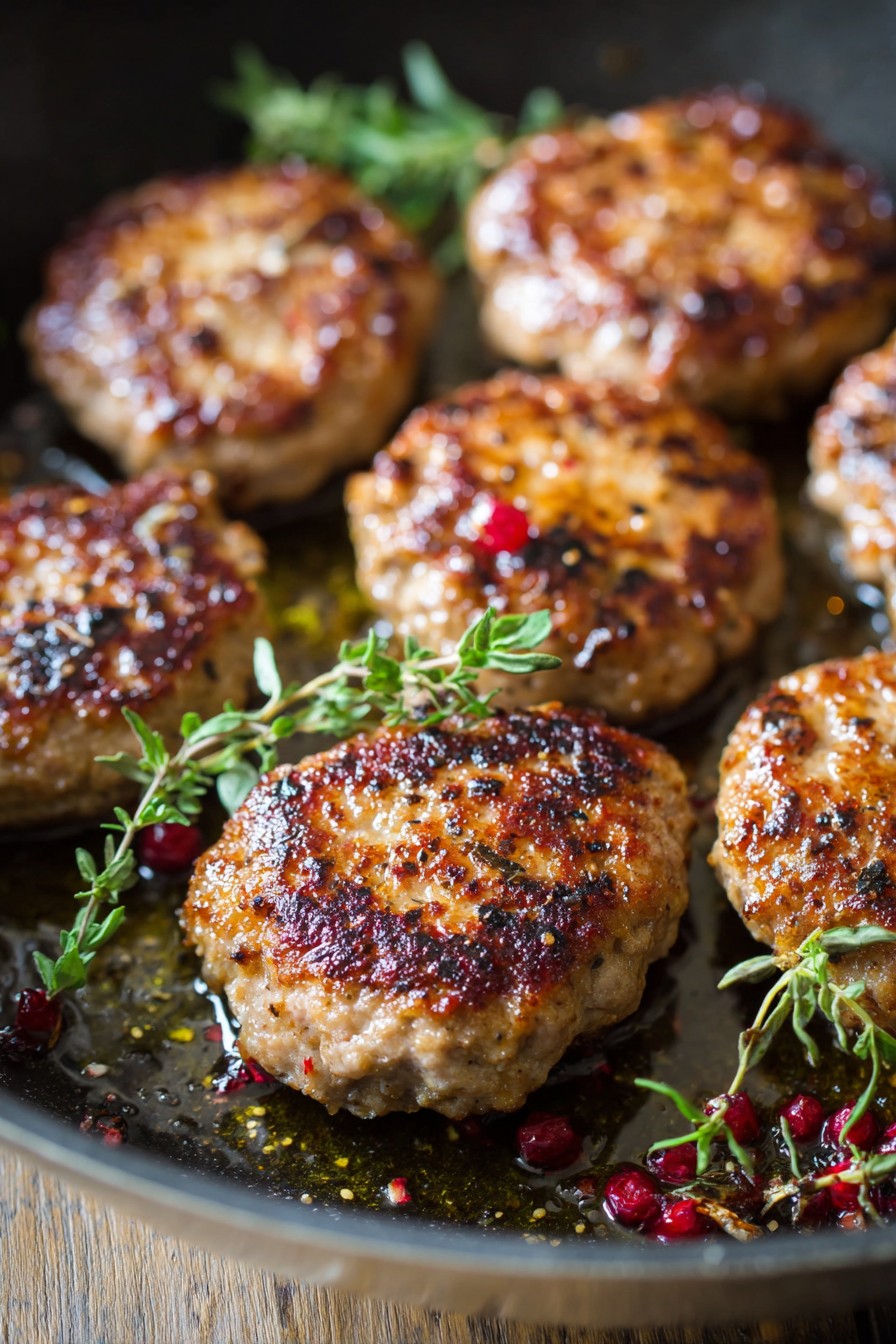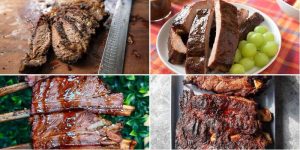Forget store-bought breakfast sausage. These homemade patties deliver fresh flavor and perfect texture with minimal effort. You control the ingredients and seasoning for a breakfast staple that beats anything from the freezer aisle.
Why This Recipe Works
- Ground pork shoulder provides the ideal fat-to-lean ratio for juicy patties that hold together during cooking without becoming greasy
- The spice blend balances savory sage with warming black pepper and subtle sweetness from maple syrup, creating complex flavor without overwhelming the pork
- Chilling the shaped patties before cooking ensures they maintain their form and cook evenly throughout, preventing crumbling or uneven browning
- Pan-frying in a cast iron skillet creates a crisp exterior while keeping the interior moist and tender, delivering textural contrast in every bite
- Simple ingredients and straightforward technique make this accessible for cooks of all skill levels while yielding professional-quality results
Ingredients
- 1 pound ground pork (80% lean, 20% fat)
- 1 teaspoon kosher salt
- 1 teaspoon dried sage
- 1/2 teaspoon black pepper, freshly ground
- 1/2 teaspoon brown sugar
- 1/4 teaspoon dried thyme
- 1/4 teaspoon red pepper flakes
- 1 tablespoon maple syrup
- 1 tablespoon olive oil for cooking
Equipment Needed
- Mixing bowl
- Cast iron skillet
- Measuring spoons
- Plate or baking sheet
- Spatula
- Paper towels
Instructions

Combine Seasonings and Pork
Place the ground pork in a medium mixing bowl. Add kosher salt, dried sage, black pepper, brown sugar, dried thyme, and red pepper flakes directly onto the pork. Drizzle the maple syrup over the seasoning mixture. Use your hands to gently combine all ingredients until just incorporated, being careful not to overmix the pork. Overmixing can cause the proteins to bind too tightly, resulting in tough, dense patties. The mixture should appear evenly distributed but still loose. Proper mixing technique ensures tender patties with good texture. Work quickly and stop as soon as no dry spots remain visible. The goal is uniform seasoning distribution without compacting the meat.
Shape the Patties
Divide the sausage mixture into eight equal portions, approximately 2 ounces each. Gently form each portion into a round patty about 1/2-inch thick and 3 inches in diameter. Avoid pressing too firmly or compacting the meat, as this can make the patties dense. Create a slight indentation in the center of each patty with your thumb to prevent doming during cooking. Place the shaped patties on a plate or baking sheet lined with parchment paper. For best results, chill the patties in the refrigerator for at least 30 minutes before cooking. This resting period allows the flavors to meld and helps the patties hold their shape during cooking.
Preheat Cooking Surface
Place a cast iron skillet over medium heat and allow it to preheat for 3-4 minutes. Add 1 tablespoon of olive oil and swirl to coat the bottom evenly. Test the skillet temperature by sprinkling a few drops of water – they should sizzle and evaporate quickly. The ideal cooking temperature is 350°F, which creates a good sear without burning the exterior. Proper preheating ensures even cooking and prevents the patties from sticking to the surface. A well-heated skillet also helps develop the Maillard reaction, creating flavorful browning on the patty surfaces while keeping the interiors juicy.
Cook the First Side
Arrange the chilled patties in the preheated skillet, leaving about 1 inch between them for proper air circulation. Cook for 4-5 minutes without moving them to develop a golden-brown crust. You should see the edges beginning to turn opaque and small amounts of liquid accumulating on the surface. Resist the temptation to press down on the patties with your spatula, as this squeezes out valuable juices. The first side should develop deep browning while the internal temperature reaches approximately 130°F. Proper browning on the first side creates flavor foundation and helps prevent sticking when flipping.
Flip and Finish Cooking
Use a spatula to carefully flip each patty, making sure to get underneath the browned crust. Cook for another 4-5 minutes on the second side until the patties reach an internal temperature of 160°F when measured with an instant-read thermometer. The second side will develop slightly less browning than the first but should still show golden color. The patties should feel firm to the touch but still have some give. For extra crispness, you can cook for an additional minute per side, but monitor the internal temperature closely to prevent drying out.
Rest Before Serving
Transfer the cooked patties to a plate lined with paper towels to absorb excess grease. Let them rest for 3-4 minutes before serving. This resting period allows the juices to redistribute throughout the patties, resulting in more tender and flavorful sausage. The internal temperature will continue to rise by about 5 degrees during this time, reaching the safe final temperature of 165°F. Resting also makes the patties easier to handle and improves their texture. Serve immediately or hold in a warm oven for up to 20 minutes.
Tips and Tricks
For optimal flavor development, consider mixing the seasoning blend a day ahead and storing it separately, then combining with the pork just before shaping. This allows the dried herbs to hydrate and the flavors to meld more completely. When working with the pork, keep everything cold – you can even chill your mixing bowl in the freezer for 15 minutes before starting. Cold fat renders better during cooking, creating juicier patties. If you prefer thinner, crispier patties, press them to 1/4-inch thickness and reduce cooking time to 3 minutes per side. For thicker, juicier patties, form them to 3/4-inch thickness and increase cooking time to 6-7 minutes per side, reducing heat to medium-low to prevent burning. When testing for doneness, look for clear juices running from the patties rather than pink liquid. The internal color should be uniformly grayish-brown with no pink remaining. If making ahead, you can shape the patties and freeze them raw on a baking sheet before transferring to freezer bags. They’ll keep for up to 3 months and can be cooked directly from frozen by adding 2-3 minutes to each side. For consistent sizing, use a kitchen scale to portion the meat or a 1/4-cup measuring cup as a guide. If your patties are browning too quickly, reduce the heat slightly and cover the skillet for the last few minutes to ensure they cook through without burning. For extra flavor, you can toast the whole spices before grinding them, or add a tablespoon of apple cider vinegar to the mixture for brightness. Always pat the patties dry with paper towels after resting to remove excess surface grease.
Recipe Variations
- Apple Sage Variation: Add 1/2 cup finely diced apple and 1 additional teaspoon of dried sage to the basic mixture. The apple adds subtle sweetness and moisture while complementing the traditional sage flavor. Reduce maple syrup to 2 teaspoons to balance the added sweetness from the fruit. This variation works particularly well for autumn breakfasts or holiday meals.
- Spicy Southwest Style: Replace sage with 2 teaspoons chili powder and 1 teaspoon cumin. Add 1/4 cup finely diced green chilies and 1 minced garlic clove. Increase red pepper flakes to 1/2 teaspoon for additional heat. This creates a bold, spicy patty perfect for breakfast burritos or topping huevos rancheros.
- Maple Breakfast Links: Add 2 additional tablespoons maple syrup and form the mixture into 2-inch links instead of patties. Reduce salt to 3/4 teaspoon to balance the sweetness. Cook links for 8-10 minutes, rolling frequently to brown all sides. The higher sugar content creates excellent caramelization.
- Italian Herb Version: Substitute sage with 2 teaspoons Italian seasoning blend and add 1/4 cup grated Parmesan cheese. Include 1 minced garlic clove and replace maple syrup with 1 tablespoon white wine. This Mediterranean-inspired variation works well for breakfast sandwiches or pasta dishes.
- Chicken-Turkey Lean Blend: Replace pork with 1/2 pound ground chicken and 1/2 pound ground turkey. Increase olive oil to 2 tablespoons for cooking and add 1 tablespoon breadcrumbs to help bind the leaner meats. The result is a lighter patty with 40% less fat while maintaining good texture.
Frequently Asked Questions
Can I use ground turkey instead of pork?
Yes, ground turkey works as a substitute but requires adjustments. Turkey is much leaner than pork, so add 2 tablespoons of olive oil to the mixture to prevent dryness. The cooking time may be slightly shorter since turkey cooks faster than pork. Use an instant-read thermometer to ensure doneness at 165°F. The flavor will be milder, so you might want to increase the seasoning quantities by about 25%. Turkey patties are more delicate, so handle them carefully when flipping.
How long do cooked sausage patties last in the refrigerator?
Properly stored cooked sausage patties will maintain quality for 3-4 days in the refrigerator. Place them in an airtight container or wrap tightly in plastic wrap. The patties can be reheated in a skillet over medium heat for 2-3 minutes per side, in a 350°F oven for 8-10 minutes, or in the microwave for 30-45 seconds. For best results, reheat gently to prevent further moisture loss. Always check that the internal temperature reaches 165°F when reheating.
Can I freeze the uncooked patty mixture?
Yes, the uncooked patty mixture freezes well for up to 3 months. Shape the patties first, then place them on a parchment-lined baking sheet and freeze until solid. Transfer the frozen patties to freezer bags, removing as much air as possible. You can cook them directly from frozen by adding 2-3 minutes to each side cooking time. Freezing the shaped patties separately prevents them from sticking together and allows you to cook individual portions as needed.
Why do my sausage patties fall apart when cooking?
Patties may fall apart due to insufficient fat content, overmixing, or insufficient chilling. Ensure your pork has at least 20% fat content for proper binding. Mix the ingredients just until combined – overworking the meat breaks down proteins that help hold the patties together. Always chill the shaped patties for at least 30 minutes before cooking to firm up the fat. If problems persist, add 1 tablespoon of breadcrumbs or 1 egg white to help bind the mixture.
Can I bake these sausage patties instead of pan-frying?
Baking is an effective alternative cooking method. Arrange patties on a parchment-lined baking sheet and bake at 375°F for 18-22 minutes, flipping halfway through. Baking produces slightly less browning but more even cooking throughout. For better browning when baking, brush the patties lightly with oil before cooking. Baking works particularly well when making larger batches, as you can cook multiple patties simultaneously without monitoring individual pieces.
Summary
Homemade breakfast sausage patties offer superior flavor and texture control. The simple technique of proper mixing, shaping, and temperature management yields restaurant-quality results. Customize seasonings to personal preference and enjoy fresh patties or frozen for convenience.
Breakfast Sausage Patties
6
servings15
minutes10
minutesIngredients
Instructions
- 1 Combine ground pork with all seasonings and maple syrup in a mixing bowl. Mix gently until just incorporated.
- 2 Divide mixture into 8 equal portions and shape into 1/2-inch thick patties. Chill for 30 minutes.
- 3 Heat olive oil in cast iron skillet over medium heat. Cook patties 4-5 minutes per side until internal temperature reaches 160°F.
- 4 Transfer to paper towel-lined plate and rest for 3-4 minutes before serving.



